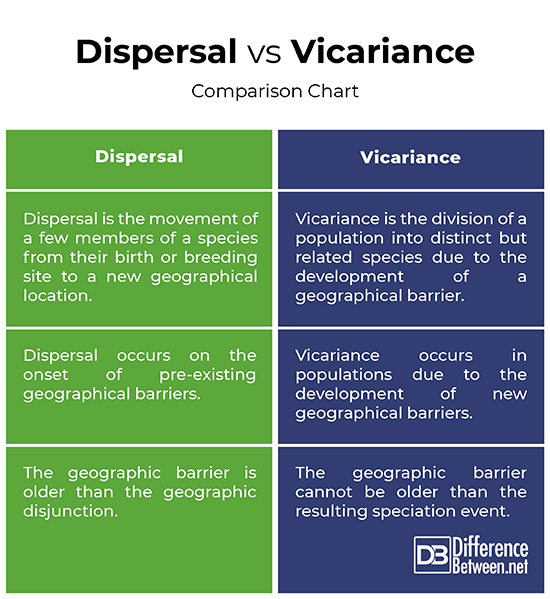Difference Between Dispersal and Vicariance
There is life all over the planet but not every species lives everywhere. There must be some logical explanation for why different species live where they do. They could be distributed randomly but it’s not possible because not every species is found everywhere. They could live wherever it is appropriate for them ecologically, which is also not the case because polar bears are found in the North Pole but not the South Pole. Or they could live in places where they can thrive in. Dispersal and vicariance are two biogeographical processes traditionally used to explain the existence of geographic distribution of organisms.

What is Dispersal?
Dispersal refers to the movement of living organisms from a birth or breeding site to a breeding or growing site. It could be a plant, animal, bacteria, or fungi. Dispersal, as the name suggests, is any movement from a living organism’s original place of birth to any place where they will establish their adult life and reproduce. Technically, dispersal can be broadly defined as any movement that has the potential consequences for gene flow. Dispersal plays a prominent role in meta-population and evolves as a direct result of any kind of alteration in the biotic and abiotic environment. It significantly changes the potential to local adaptation.
The act of dispersal is basically a three-step process: first step is the departure from the local environment, second is movement across a more or less hostile environment, and third is settlement in the new habitat. Dispersal is a common biological phenomenon that occurs within living organisms at different stages of the life cycle and in response to several ecological or environmental factors. It is the main mechanism that leads to gene flow within and between populations. One form of biological dispersal is called natal dispersal which refers to the first movement away from a birth site to a place of first reproduction.

What is Vicariance?
Vicariance, or long distance dispersal, refers to the geographical separation of a large group of organisms from the population in promoting biological evolution. It is the primary model of alloptaric speciation and a competing explanation of the geographic distribution of organisms. In vicariance, the population is divided into sub-populations by the development of geographic barriers they cannot cross. A population is sub-divided into distinct but related species due to a geographical barrier, which may completely prevent gene flow between populations on either side. This leads to genetic differentiation between the two groups of populations.
This geographic barrier could be a geological feature that makes it hard for the species to cross or it could be anything from natural to climatic events such as rivers, mountains, volcano, earthquakes, or anything that create a barrier between the species. Once parted, the populations evolve independently and diverge, and become increasingly different over time as different mutations occur and proliferate in each population. As these mutations accumulate the two sets of populations become increasingly separated and different, and as a result, they lose the ability of reproduce with each other.
Difference between Dispersal and Vicariance
Process
– Both dispersal and vicariance are prominent biogeographical processes traditionally used to explain the existence of geographic distribution of organisms. Dispersal is the movement of a few members of a species from their birth or breeding site to a new geographical location where they can reproduce. In vicariance, a population is sub-divided into distinct but related species due to a geographical barrier, which may completely prevent gene flow between populations on either side.
Cause
– Dispersal takes organisms away from their place of birth, and this process is driven by a combination of individual characteristics and environmental effects. It can be explained by variation in morphological, physiological, or behavioral traits that affect individual’s movement and orientation capacity. Dispersal occurs on the onset of pre-existing geographical barriers. Vicariance, on the other hand, occurs in populations due to the development of geographical barriers they cannot cross, such as continental drift, formation of mountains, islands, bodies of water, or other climatic conditions, such as earthquakes, volcanic eruption, etc.
Dispersal vs. Vicariance: Comparison Chart

Summary
Both dispersal and vicariance are recognized as significant biogeographic processes, but neither takes precedence over the analysis of distributional patterns. Vicariance can be sub-divided into three kinds of events: vicariance followed by speciation, vicariance that lacks allopatric speciation, and vicariance followed by speciation after a previous speciation event independent of the vicariance of the two locations. Dispersal is highly diverse in its mechanisms, and thus inevitably invokes a great number of potential causes.
Which of the following is a major difference between Vicariant vs dispersal Allopatry?
Dispersal refers to the movement of organisms from their breeding site to a new geographical location whereas vicariance is the division of a large population into two sister species due to the development of new geographic barriers.
What is dispersal vicariance analysis?
Dispersal-Vicariance Analysis is one of the most widely used methods used for inferring biogeographic histories. The model was proposed by Ronquist to study associations between organisms. This model reconstructs the taxon ancestral distribution on the basis of a simple biographic model.
What are examples of vicariance?
A great example of vicariance is the divergence of marine creatures on either side of Central America after the closure of Isthmus of Panama.
What is the meaning of Allopolyploid?
Allopolyploids are polyploids whose chromosomes are derived from different species. Every cell has multiple sets of chromosomes, each of which is derived from two or more diverged taxa.
- Difference Between Caucus and Primary - June 18, 2024
- Difference Between PPO and POS - May 30, 2024
- Difference Between RFID and NFC - May 28, 2024
Search DifferenceBetween.net :
Leave a Response
References :
[0]Nei, Masatoshi. Mutation-Driven Evolution. Oxford, United Kingdom: Oxford University Press, 2013. Print
[1]Kliman, Richard M. Encyclopedia of Evolutionary Biology. Massachusetts, United States: Academic Press, 2016. Print
[2]Cox, C. Barry, et al. Biogeography: An Ecological and Evolutionary Approach. New Jersey, United States: John Wiley & Sons, 2020. Print
[3]Clobert, Jean, et al. Dispersal Ecology and Evolution. Oxford, United Kingdom: Oxford University Press, 2012. Print
[4]Huggett, Richard John. Fundamentals of Biogeography. Oxfordshire, England: Routledge, 2004. Print
[5]Bullock, James M., et al. Dispersal Ecology: 42nd Symposium of the British Ecological Society. Cambridge, United Kingdom: Cambridge University Press, 2002. Print
[6]Crisci, Jorge, et al. Historical Biogeography: An Introduction. Massachusetts, United States: Harvard University Press, 2009. Print
[7]“Biological dispersal.” Wikipedia, Wikimedia Commons, 10 Mar. 2022, https://en.wikipedia.org/wiki/Biological_dispersal. Accessed 6 Apr. 2022.
